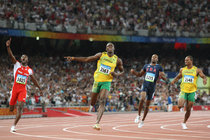"For breath is life, and if you breathe well you will live long on earth." -- Sanskrit proverb.
With the opening of the Olympics in Brazil this week, focusing on the breath is timely. Without proper use and training their respirations, athletes wouldn't be able to accomplish their amazing physical feats. On a perhaps less ambitious but no less vital scale, we can become a kind of athlete by paying attention to our everyday breathing.
By the end of reading this blog, you will understand why literally everything depends on the breath. Of course without it, we don't have life. But we rarely think of the extent to which proper breathing affects our health.
First, a bit about the anatomy of the respiratory system: It consists of the nose (nasal passages), trachea, diaphragm, bronchi and bronchioles all the way down to the tiny air sacs at the base of the lungs. Good-enough breathing depends on using muscles that include the diaphragm, intercostal muscles (between the ribs) and the abdominal muscles. When we don't breathe fully we don't circulate the air down to the alveoli or tiny air sacs.
The two main types of breathing are superficial or chest breathing, which involves the expansion of the chest, and deep or abdominal breathing., which engages the abdomen.
For the most part, breathing is automatic. If it weren't, the attention we'd have to pay to it would detract from our daily activities. But if breathing is automatic, how can we forget? Yet when the coach asks, "Are you breathing?" we realize that we haven't been breathing. Instead, we had focused on the exercise and held our breath, a counterproductive, but not uncommon, behavior.
Not infrequently, we hear in the course of an exercise class, the instructor remind us to breathe, " Breathe to the bottom of the lobes; she might advise. "That's where the calmness is." Obviously good breathing doesn't come naturally.
Ignoring the mechanics of breathing handicaps us. Disorders of breathing cause physical symptoms. and we rarely realize how simple it is to correct these symptoms. Under stress we tend to hold our breath, which may compromise our body's ability to stave off disease, helping to explain our tendency to become ill under stressful circumstances. Common sense suggests that deep breathing enhances the flow of air that prevents bacteria, viruses and fungi from settling in our lungs.
Failure to use our abdominal muscles can cause health problems like poor posture, which leads to problems with balance and the potential to fall.
Abdominal breathing helps us to become aware of the muscles that support our frame. In addition, we burn more calories when we put our muscles to use. Abdominal breathing involves the large muscles that support the abdominal cavity and utilizes more calories than the shallow breathing that involves the smaller intercostal muscles located between the ribs. One fitness instructor, Jill Johnson, even invented a weight-loss regimen called Oxycise based on breathing from the stomach.
The added benefit for using the breath as exercise is that we don't need a gym, i a change of clothes or even additional time. We can perform deep breathing while remaining in our seats in a classroom or an office by focusing on our respirations.
We can wake ourselves up by increasing our oxygen level by breathing deeply. Or conversely, we can put ourselves to sleep with a kind of meditation of shallow breathing, and repeating silently the words to the rhythmic "in" and "out" like a mantra.
When we feel out of control, remembering that we can modulate the breathing has the power to give us an immediate sense of control. Mr. G. treated his flying phobia by focusing on his inhales and exhales. Ms. K. treated her panic attacks, exacerbated by light-headedness resulting from breathing too quickly and over-oxygenating the blood, by breathing in and out of a paper bag.
We may not be aware of our anxious state, but experience chest pain or pressure caused by holding our breath. If so, inhaling deeply will give relief. (Of course, if the cause is more serious, the discomfort won't disappear.)
Conclusion: A focus on the breath grants everyone the power to become an athlete and a self-healer.
